ignition FORD ESCAPE 2008 2.G Repair Manual
[x] Cancel search | Manufacturer: FORD, Model Year: 2008, Model line: ESCAPE, Model: FORD ESCAPE 2008 2.GPages: 296, PDF Size: 2.77 MB
Page 212 of 296
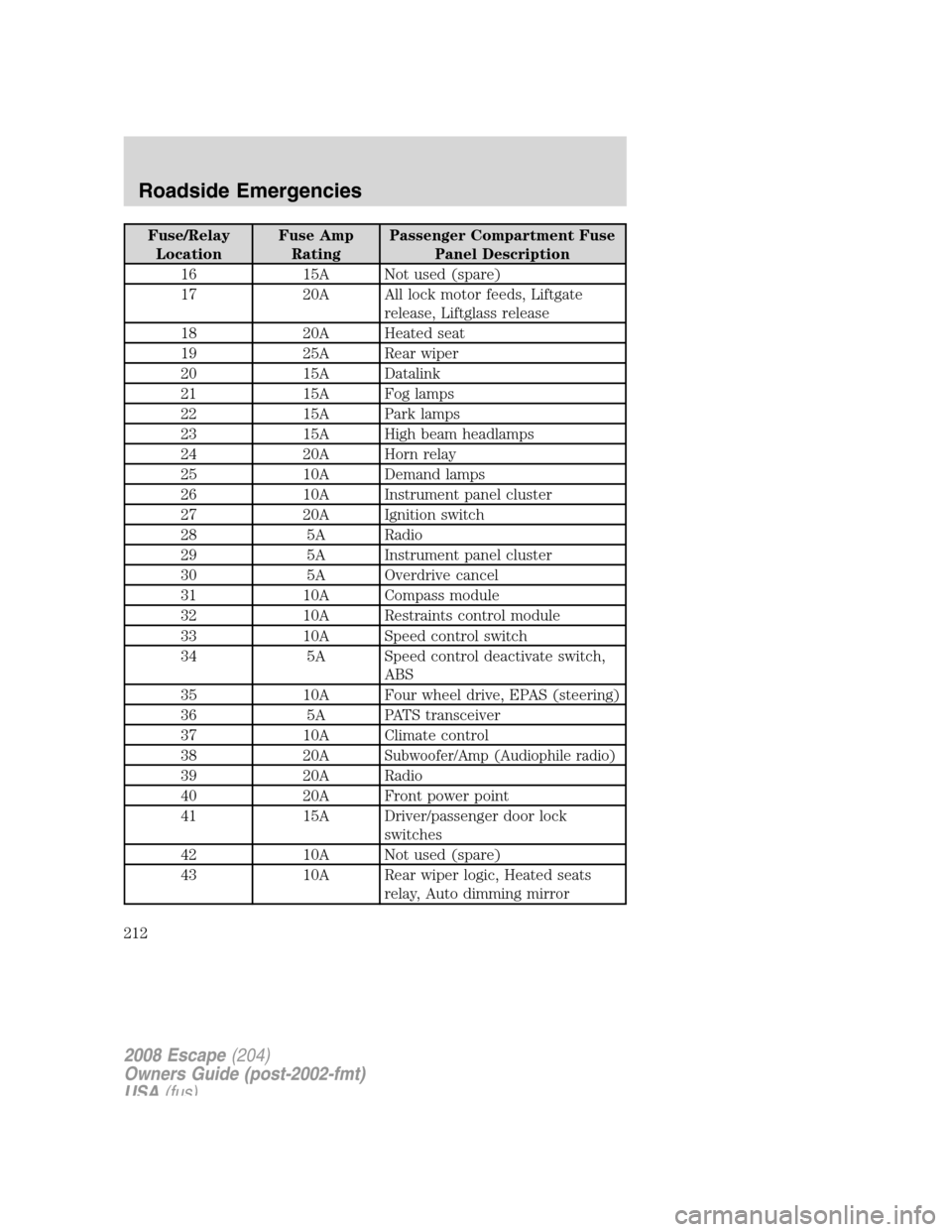
Fuse/RelayLocation Fuse Amp
Rating Passenger Compartment Fuse
Panel Description
16 15A Not used (spare)
17 20A All lock motor feeds, Liftgate release, Liftglass release
18 20A Heated seat
19 25A Rear wiper
20 15A Datalink
21 15A Fog lamps
22 15A Park lamps
23 15A High beam headlamps
24 20A Horn relay
25 10A Demand lamps
26 10A Instrument panel cluster
27 20A Ignition switch
28 5A Radio
29 5A Instrument panel cluster
30 5A Overdrive cancel
31 10A Compass module
32 10A Restraints control module
33 10A Speed control switch
34 5A Speed control deactivate switch, ABS
35 10A Four wheel drive, EPAS (steering)
36 5A PATS transceiver
37 10A Climate control
38 20A
Subwoofer/Amp (Audiophile radio)
39 20A Radio
40 20A Front power point
41 15A Driver/passenger door lock switches
42 10A Not used (spare)
43 10A Rear wiper logic, Heated seats relay, Auto dimming mirror
2008 Escape(204)
Owners Guide (post-2002-fmt)
USA (fus)
Roadside Emergencies
212
Page 215 of 296
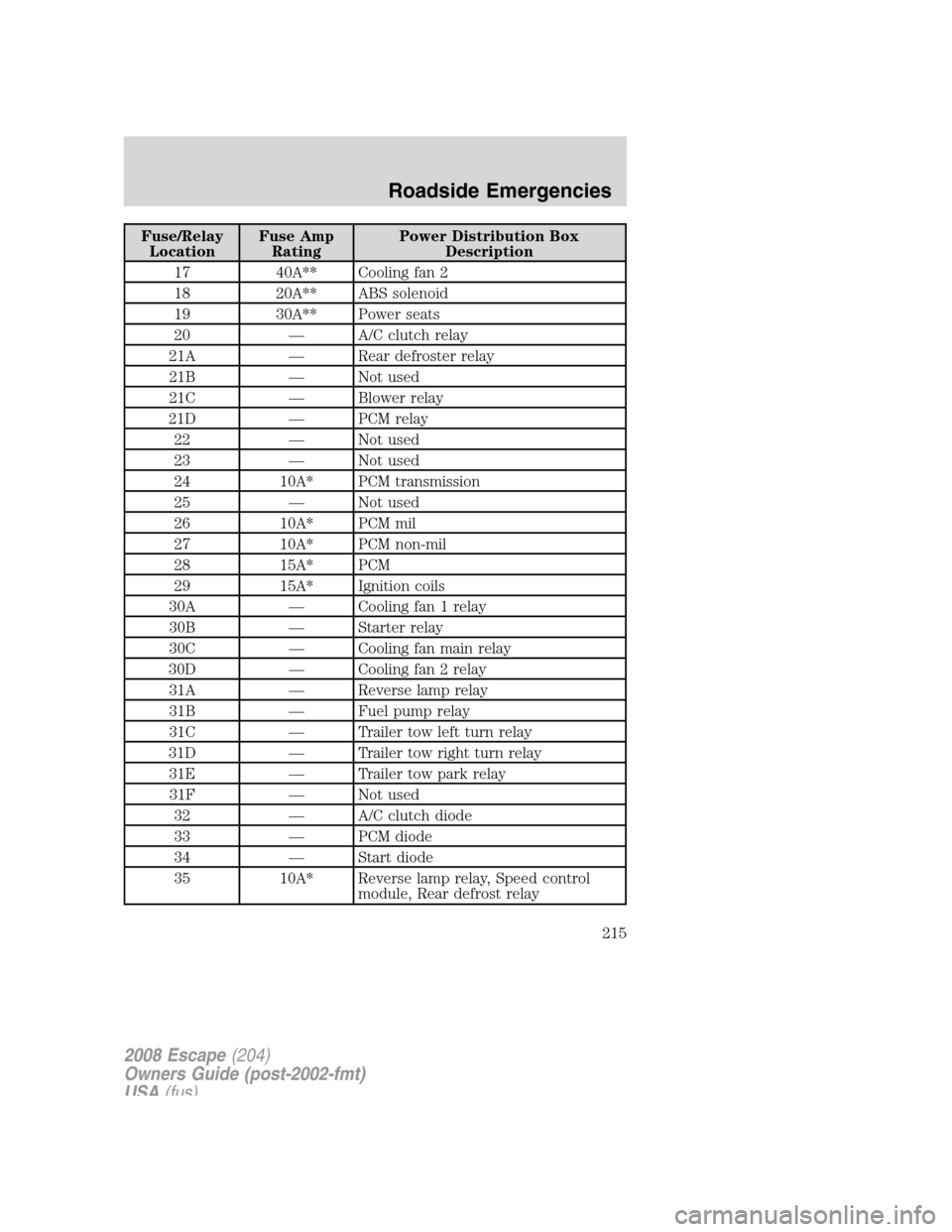
Fuse/RelayLocation Fuse Amp
Rating Power Distribution Box
Description
17 40A** Cooling fan 2
18 20A** ABS solenoid
19 30A** Power seats
20 — A/C clutch relay
21A — Rear defroster relay 21B — Not used
21C — Blower relay
21D — PCM relay 22 — Not used
23 — Not used
24 10A* PCM transmission
25 — Not used
26 10A* PCM mil
27 10A* PCM non-mil
28 15A* PCM
29 15A* Ignition coils
30A — Cooling fan 1 relay 30B — Starter relay
30C — Cooling fan main relay
30D — Cooling fan 2 relay 31A — Reverse lamp relay31B — Fuel pump relay
31C — Trailer tow left turn relay
31D — Trailer tow right turn relay 31E — Trailer tow park relay 31F — Not used 32 — A/C clutch diode
33 — PCM diode
34 — Start diode
35 10A* Reverse lamp relay, Speed control module, Rear defrost relay
2008 Escape(204)
Owners Guide (post-2002-fmt)
USA (fus)
Roadside Emergencies
215
Page 269 of 296
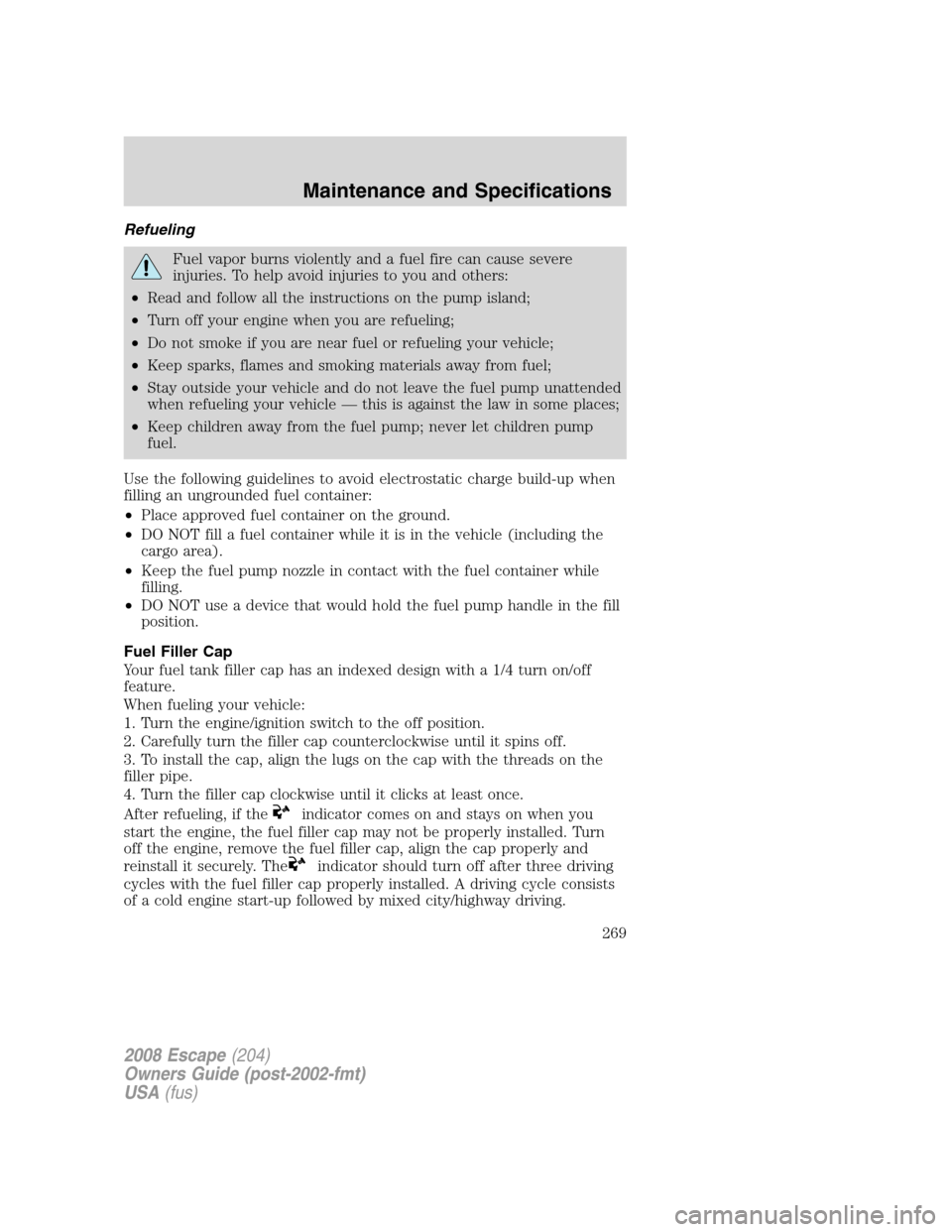
Refueling
Fuel vapor burns violently and a fuel fire can cause severe
injuries. To help avoid injuries to you and others:
•Read and follow all the instructions on the pump island;
•Turn off your engine when you are refueling;
•Do not smoke if you are near fuel or refueling your vehicle;
•Keep sparks, flames and smoking materials away from fuel;
•Stay outside your vehicle and do not leave the fuel pump unattended
when refueling your vehicle — this is against the law in some places;
•Keep children away from the fuel pump; never let children pump
fuel.
Use the following guidelines to avoid electrostatic charge build-up when
filling an ungrounded fuel container:
•Place approved fuel container on the ground.
•DO NOT fill a fuel container while it is in the vehicle (including the
cargo area).
•Keep the fuel pump nozzle in contact with the fuel container while
filling.
•DO NOT use a device that would hold the fuel pump handle in the fill
position.
Fuel Filler Cap
Your fuel tank filler cap has an indexed design with a 1/4 turn on/off
feature.
When fueling your vehicle:
1. Turn the engine/ignition switch to the off position.
2. Carefully turn the filler cap counterclockwise until it spins off.
3. To install the cap, align the lugs on the cap with the threads on the
filler pipe.
4. Turn the filler cap clockwise until it clicks at least once.
After refueling, if the
indicator comes on and stays on when you
start the engine, the fuel filler cap may not be properly installed. Turn
off the engine, remove the fuel filler cap, align the cap properly and
reinstall it securely. The
indicator should turn off after three driving
cycles with the fuel filler cap properly installed. A driving cycle consists
of a cold engine start-up followed by mixed city/highway driving.
2008 Escape(204)
Owners Guide (post-2002-fmt)
USA(fus)
Maintenance and Specifications
269
Page 272 of 296
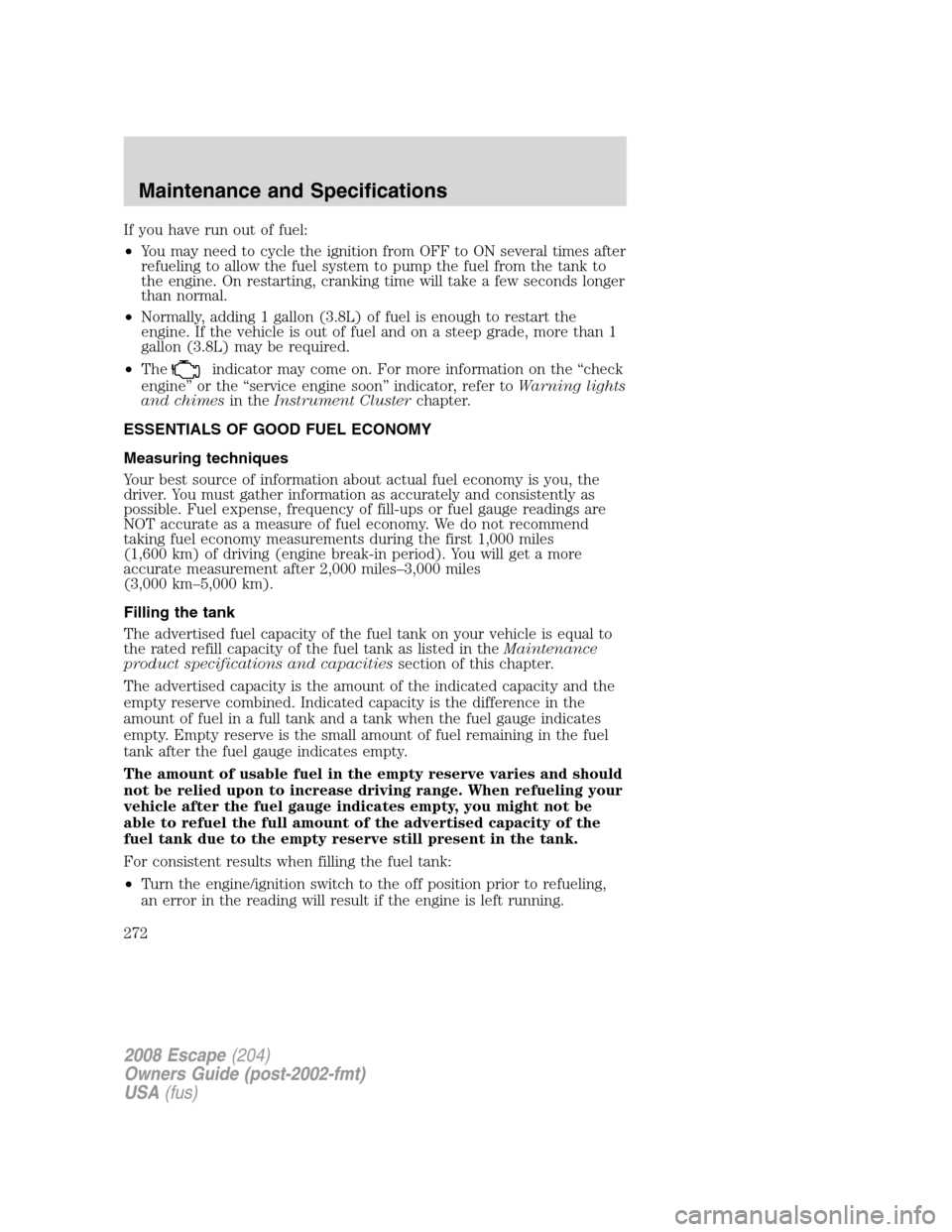
If you have run out of fuel:
•You may need to cycle the ignition from OFF to ON several times after
refueling to allow the fuel system to pump the fuel from the tank to
the engine. On restarting, cranking time will take a few seconds longer
than normal.
•Normally, adding 1 gallon (3.8L) of fuel is enough to restart the
engine. If the vehicle is out of fuel and on a steep grade, more than 1
gallon (3.8L) may be required.
•The
indicator may come on. For more information on the “check
engine” or the “service engine soon” indicator, refer toWarning lights
and chimesin theInstrument Clusterchapter.
ESSENTIALS OF GOOD FUEL ECONOMY
Measuring techniques
Your best source of information about actual fuel economy is you, the
driver. You must gather information as accurately and consistently as
possible. Fuel expense, frequency of fill-ups or fuel gauge readings are
NOT accurate as a measure of fuel economy. We do not recommend
taking fuel economy measurements during the first 1,000 miles
(1,600 km) of driving (engine break-in period). You will get a more
accurate measurement after 2,000 miles–3,000 miles
(3,000 km–5,000 km).
Filling the tank
The advertised fuel capacity of the fuel tank on your vehicle is equal to
the rated refill capacity of the fuel tank as listed in theMaintenance
product specifications and capacitiessection of this chapter.
The advertised capacity is the amount of the indicated capacity and the
empty reserve combined. Indicated capacity is the difference in the
amount of fuel in a full tank and a tank when the fuel gauge indicates
empty. Empty reserve is the small amount of fuel remaining in the fuel
tank after the fuel gauge indicates empty.
The amount of usable fuel in the empty reserve varies and should
not be relied upon to increase driving range. When refueling your
vehicle after the fuel gauge indicates empty, you might not be
able to refuel the full amount of the advertised capacity of the
fuel tank due to the empty reserve still present in the tank.
For consistent results when filling the fuel tank:
•Turn the engine/ignition switch to the off position prior to refueling,
an error in the reading will result if the engine is left running.
2008 Escape(204)
Owners Guide (post-2002-fmt)
USA(fus)
Maintenance and Specifications
272
Page 275 of 296

•Fuel economy may decrease with lower temperatures during the first
8–10 miles (12–16 km) of driving.
•Driving on flat terrain offers improved fuel economy as compared to
driving on hilly terrain.
•Transmissions give their best fuel economy when operated in the top
cruise gear and with steady pressure on the gas pedal.
•Close windows for high speed driving.
EPA window sticker
Every new vehicle should have the EPA window sticker. Contact your
authorized dealer if the window sticker is not supplied with your vehicle.
The EPA window sticker should be your guide for the fuel economy
comparisons with other vehicles.
It is important to note the box in the lower left corner of the window
sticker. These numbers represent the Range of MPG (L/100 km)
expected on the vehicle under optimum conditions. Your fuel economy
may vary depending upon the method of operation and conditions.
EMISSION CONTROL SYSTEM
Your vehicle is equipped with various emission control components and a
catalytic converter which will enable your vehicle to comply with
applicable exhaust emission standards. To make sure that the catalytic
converter and other emission control components continue to work
properly:
•Use only the specified fuel listed.
•Avoid running out of fuel.
•Do not turn off the ignition while your vehicle is moving, especially at
high speeds.
•Have the items listed inscheduled maintenance information
performed according to the specified schedule.
The scheduled maintenance items listed inscheduled maintenance
informationare essential to the life and performance of your vehicle
and to its emissions system.
If other than Ford, Motorcraft or Ford-authorized parts are used for
maintenance replacements or for service of components affecting
emission control, such non-Ford parts should be equivalent to genuine
Ford Motor Company parts in performance and durability.
2008 Escape(204)
Owners Guide (post-2002-fmt)
USA(fus)
Maintenance and Specifications
275
Page 277 of 296
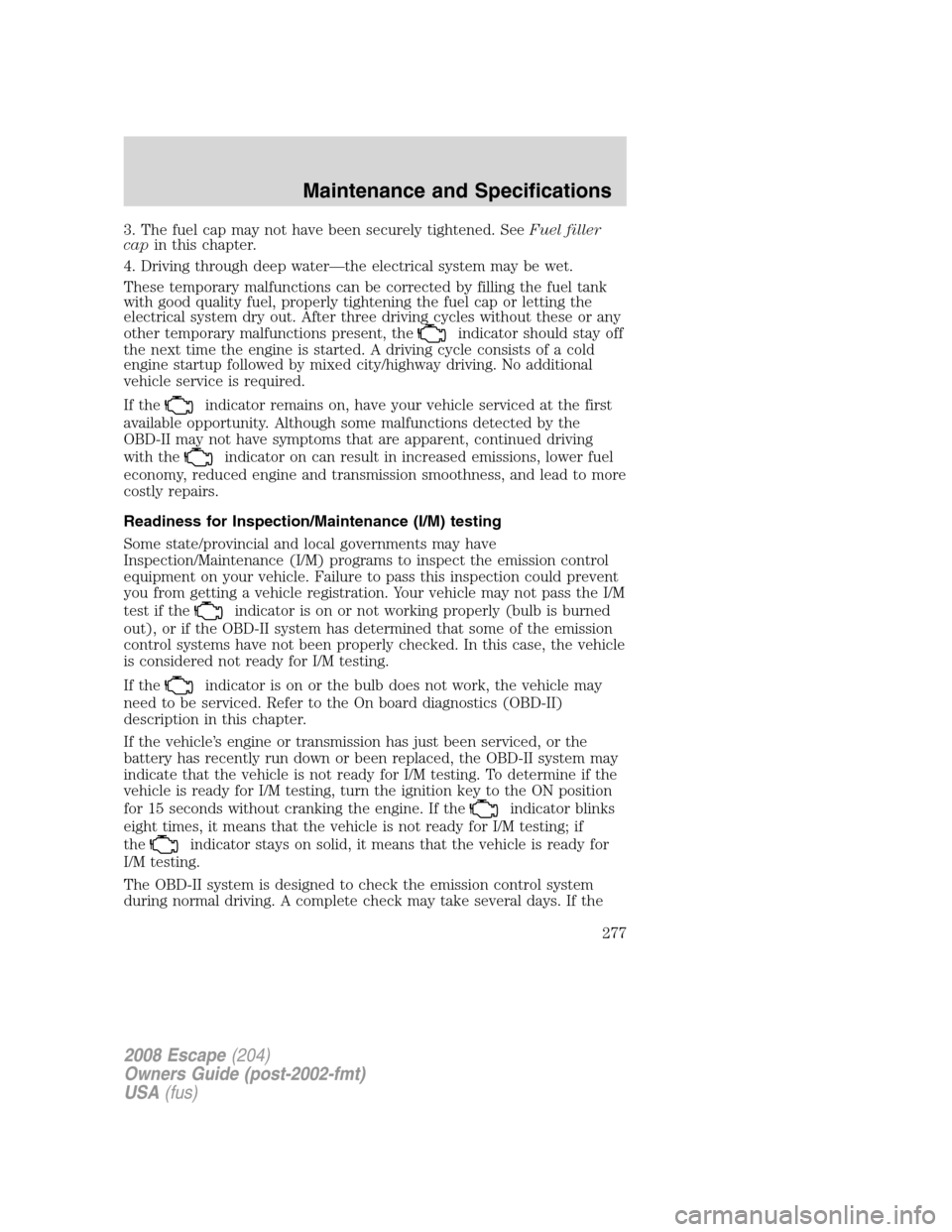
3. The fuel cap may not have been securely tightened. SeeFuel filler
capin this chapter.
4. Driving through deep water—the electrical system may be wet.
These temporary malfunctions can be corrected by filling the fuel tank
with good quality fuel, properly tightening the fuel cap or letting the
electrical system dry out. After three driving cycles without these or any
other temporary malfunctions present, the
indicator should stay off
the next time the engine is started. A driving cycle consists of a cold
engine startup followed by mixed city/highway driving. No additional
vehicle service is required.
If the
indicator remains on, have your vehicle serviced at the first
available opportunity. Although some malfunctions detected by the
OBD-II may not have symptoms that are apparent, continued driving
with the
indicator on can result in increased emissions, lower fuel
economy, reduced engine and transmission smoothness, and lead to more
costly repairs.
Readiness for Inspection/Maintenance (I/M) testing
Some state/provincial and local governments may have
Inspection/Maintenance (I/M) programs to inspect the emission control
equipment on your vehicle. Failure to pass this inspection could prevent
you from getting a vehicle registration. Your vehicle may not pass the I/M
test if the
indicator is on or not working properly (bulb is burned
out), or if the OBD-II system has determined that some of the emission
control systems have not been properly checked. In this case, the vehicle
is considered not ready for I/M testing.
If the
indicator is on or the bulb does not work, the vehicle may
need to be serviced. Refer to the On board diagnostics (OBD-II)
description in this chapter.
If the vehicle’s engine or transmission has just been serviced, or the
battery has recently run down or been replaced, the OBD-II system may
indicate that the vehicle is not ready for I/M testing. To determine if the
vehicle is ready for I/M testing, turn the ignition key to the ON position
for 15 seconds without cranking the engine. If the
indicator blinks
eight times, it means that the vehicle is not ready for I/M testing; if
the
indicator stays on solid, it means that the vehicle is ready for
I/M testing.
The OBD-II system is designed to check the emission control system
during normal driving. A complete check may take several days. If the
2008 Escape(204)
Owners Guide (post-2002-fmt)
USA(fus)
Maintenance and Specifications
277
Page 286 of 296
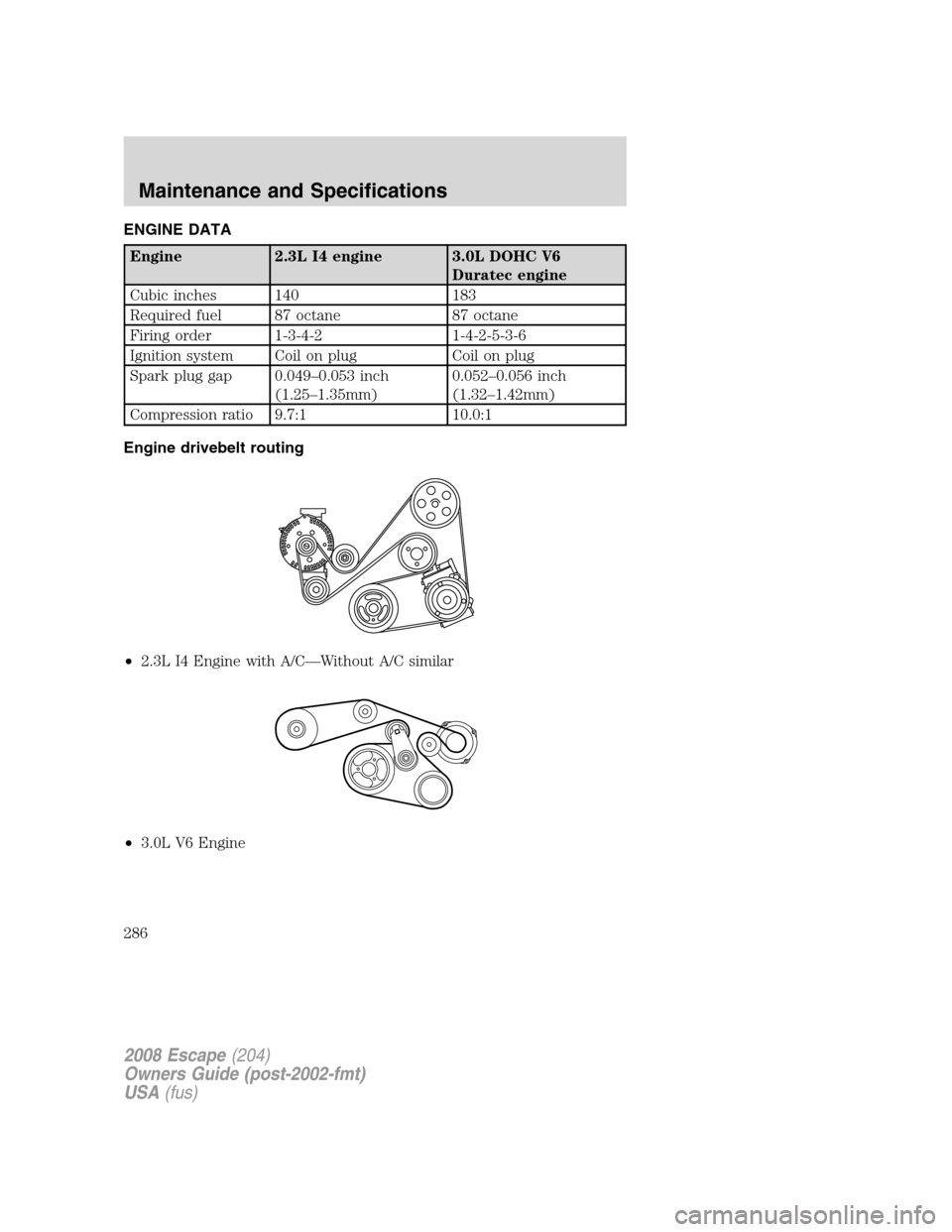
ENGINE DATA
Engine 2.3L I4 engine 3.0L DOHC V6
Duratec engine
Cubic inches 140 183
Required fuel 87 octane 87 octane
Firing order 1-3-4-2 1-4-2-5-3-6
Ignition system Coil on plug Coil on plug
Spark plug gap 0.049–0.053 inch
(1.25–1.35mm)0.052–0.056 inch
(1.32–1.42mm)
Compression ratio 9.7:1 10.0:1
Engine drivebelt routing
•2.3L I4 Engine with A/C—Without A/C similar
•3.0L V6 Engine
2008 Escape(204)
Owners Guide (post-2002-fmt)
USA(fus)
Maintenance and Specifications
286
Page 293 of 296

filter, specifications ........258, 282
recommendations ...................258
refill capacities ........................283
specifications ..........................283
Exhaust fumes ..........................181
F
Fail safe cooling ........................266
Fluid capacities .........................283
Foglamps .....................................42
Four-Wheel Drive vehicles
driving off road .......................199
preparing to drive your
vehicle .....................................189
Fuel ............................................267
calculating fuel
economy ............................67, 272
cap ...........................................269
capacity ...................................283
choosing the right fuel ...........270
comparisons with EPA fuel
economy estimates .................275
detergent in fuel .....................271
filling your vehicle with
fuel ...........................267, 269, 272
filter, specifications ........267, 282
fuel pump shut-off switch .....208
improving fuel economy ........272
octane rating ...................271, 286
quality ......................................271
running out of fuel .................271
safety information relating to
automotive fuels .....................267
Fuses ..................................209–210
G
Gas cap (see Fuel cap) ............269Gas mileage
(see Fuel economy) .................272
Gauges .........................................17
H
Hazard flashers .........................208
Head restraints .....................95, 98
Headlamps ...................................41
aiming ........................................44
bulb specifications ....................47
daytime running lights .............43
flash to pass ..............................43
high beam .................................43
replacing bulbs .........................48
turning on and off ....................41
Heating
heating and air conditioning
system .......................................37
manual heating and air
conditioning system .................34
Hood ..........................................250
I
Ignition ...............................178, 286
Illuminated visor mirror .............54
Infant seats
(see Safety seats) .....................135
Inspection/maintenance (I/M)
testing ........................................277
Instrument panel
cleaning ...................................246
cluster ........................................12
lighting up panel and
interior .......................................44
J
Jump-starting your vehicle ......227
2008 Escape(204)
Owners Guide (post-2002-fmt)
USA(fus)
Index
293
Page 294 of 296
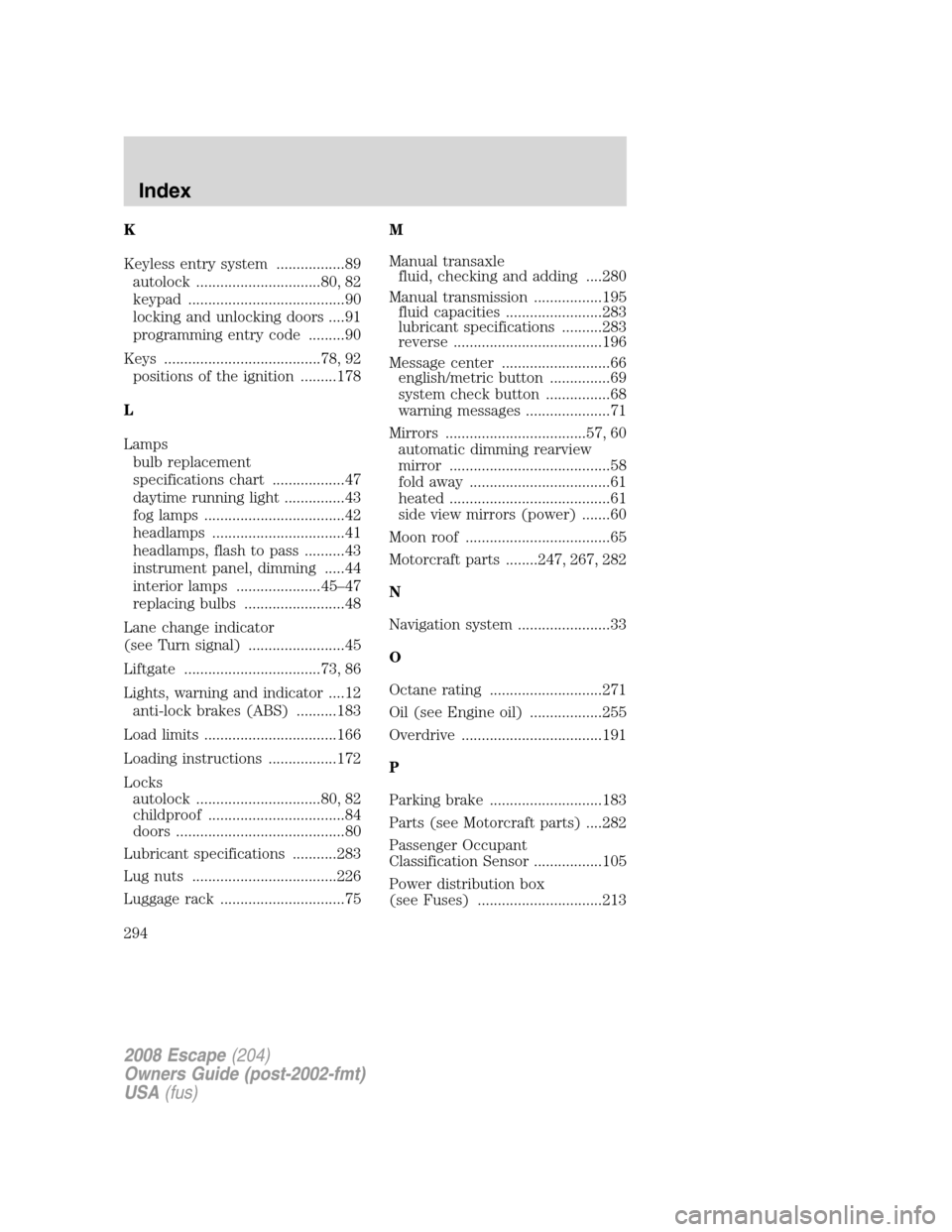
K
Keyless entry system .................89
autolock ...............................80, 82
keypad .......................................90
locking and unlocking doors ....91
programming entry code .........90
Keys .......................................78, 92
positions of the ignition .........178
L
Lamps
bulb replacement
specifications chart ..................47
daytime running light ...............43
fog lamps ...................................42
headlamps .................................41
headlamps, flash to pass ..........43
instrument panel, dimming .....44
interior lamps .....................45–47
replacing bulbs .........................48
Lane change indicator
(see Turn signal) ........................45
Liftgate ..................................73, 86
Lights, warning and indicator ....12
anti-lock brakes (ABS) ..........183
Load limits .................................166
Loading instructions .................172
Locks
autolock ...............................80, 82
childproof ..................................84
doors ..........................................80
Lubricant specifications ...........283
Lug nuts ....................................226
Luggage rack ...............................75M
Manual transaxle
fluid, checking and adding ....280
Manual transmission .................195
fluid capacities ........................283
lubricant specifications ..........283
reverse .....................................196
Message center ...........................66
english/metric button ...............69
system check button ................68
warning messages .....................71
Mirrors ...................................57, 60
automatic dimming rearview
mirror ........................................58
fold away ...................................61
heated ........................................61
side view mirrors (power) .......60
Moon roof ....................................65
Motorcraft parts ........247, 267, 282
N
Navigation system .......................33
O
Octane rating ............................271
Oil (see Engine oil) ..................255
Overdrive ...................................191
P
Parking brake ............................183
Parts (see Motorcraft parts) ....282
Passenger Occupant
Classification Sensor .................105
Power distribution box
(see Fuses) ...............................213
2008 Escape(204)
Owners Guide (post-2002-fmt)
USA(fus)
Index
294